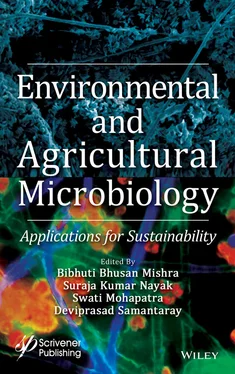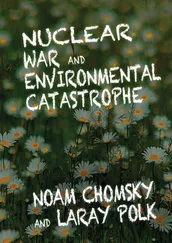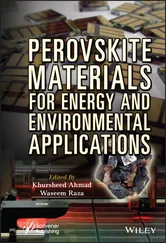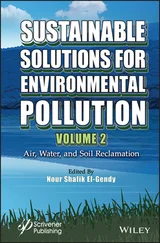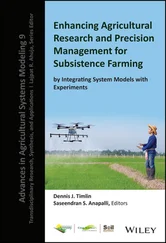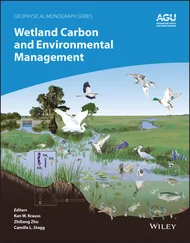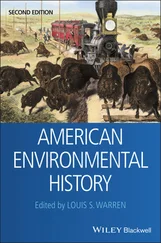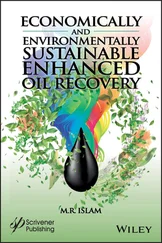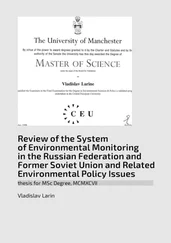1 ...8 9 10 12 13 14 ...26 Chromium toxicity can be lessened using biosorbents prepared from various microbes like bacteria, fungi, yeasts, moulds, and algae [10]. However, involvement of microalgae for the reduction of toxicity is highly recommendable due to the availability of some exclusive properties in them. Presence of different binding groups, polysaccharides, proteins, and vacuoles collectively provide a higher binding affinity with the metal and, hence, facilitate the process of bioremediation [11]. Moreover, these microbes also possess numerous advantages like high efficiency in eliminating heavy metals even from very low concentration, cheaper cost, high adsorbing capacity, larger surface area, greater mucilage area, and high binding affinity with simple nutrient requirement. Besides these, they are capable of growing in both aquatic and terrestrial area. In diverse ecosystems, algae play significant roles for which they are regarded as cosmopolitan microorganisms. They can synthesize low molecular weight thiol-peptides and reduced glutathione and phytochelatin when grown in a heavy metal polluted environment [12].
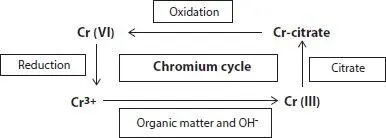
Figure 2.1 The chromium cycle.
The chromium cycle mostly comprises oxidation and reduction of Cr(III) and Cr(VI), respectively ( Figure 2.1). Although both the forms of chromium are found to have opposite characteristics (e.g., toxicity, mobility, and reactivity) but eventually both are highly dangerous when the concentration becomes high. Moreover, this cycle depicts the simultaneous reduction of Cr(VI) through some carbon compounds and the oxidation of Cr(III) in the presence of manganese oxide available in soil and sediments represented in the below equations [13].
(2.1) 
(2.2) 
2.2 Effects of Hexavalent Chromium Toxicity
2.2.1 Toxicity to Microorganisms
Chronic exposure to hexavalent chromium has many deleterious effects on the structure and function of the microbial cells, and in some cases, it also causes dormancy. It leads to species loss and disturbs the diversity. Growth of Scenedesmus acutus was inhibited when it treated with more than 15 ppm of hexavalent chromium [14]. Spirogyra sp. and Mougeotia sp. were found forming Cr(V) while exposed to Cr(VI) [15]. The lag growth phase of Euglena gracilis was lengthened when treated with Cr(VI) and motility was also lost due to the modifications in the cytoskeleton induced by Cr(VI) [16]. It was reported that the photosynthesis was inhibited due to the presence of Cr in the cells of Scenedesmus sp. and Chlorella sp. [17, 18]. The sulfate transport system mediated transport of chromate ions has diverse toxic effects in the cytoplasm of Salmonella typhimurium , Alkaligenes eutrophus , Escherichia coli , and Pseudomonas fluorescens . According to Viamajala et al., (2002) [19], the minimum concentration of Cr (VI) (0.015 mM) has slowed down the growth of Shewanella oneidensis . The reduction of growth was observed in mycelium of fungi due to the toxic effect of hexavalent chromium. Interference of chromium causes gene mutation and conversion which further lead to growth inhibition in fungal cell [16].
2.2.2 Toxicity to Plant Body
Hexavalent chromium diffuses across the cell membrane due to the structural resemblance of chromate ions to phosphate or sulphate. It can easily enter inside the cell and where the reduction takes place producing Cr(V) and then Cr(III) reactive oxygen species and free radicals [20]. Cr(III) is impermeable, so unable to cross the cellular membrane and prefers to bind the protein molecules available on the membrane surface with greater affinity causing DNA damage, inhibition of DNA replication, and RNA transcription [21]. Plant growth, development, and plant physiology (mineral nutrition, water relations, and photosynthesis) are greatly affected by hexavalent chromium [22]. The amount of chlorophyll (Chl) content, nitrate reductase activity, and δ-aminolevulinic acid contents were also reduced in plants growing in chromium contaminated soil [23]. Hexavalent chromium induces the inhibition of photosynthesis rate in terms of CO 2fixation, electron transport processes, enzyme activities, and photophosphorylation in plants [24, 25]. Bishnoi et al., (1993) [26] has observed that Cr(VI) was influencing the PS I and PS II by isolating the chloroplasts from peas. The direct effect of Cr exposure has also been found on enzymes or other metabolites that may cause increased oxidative stress and lipid peroxidation [27–29]. Consequently, herein, we can conclude three key roles of Cr on plants as follows:
1 (i) Production of a new metabolites to change the metabolic pool which would providetolerance of Cr stress (e.g., phytochelatins and histidine) [30].
2 (ii) Variation of the production in several pigments (like chlorophyll and anthocyanin) for the sustenance of plants [31].
3 (iii) Cr stress induces the production of metabolites like glutathione and ascorbic acid which may cause damage to the plants [32, 33].
2.2.3 Toxicity to Animals
People those are directly exposed to chromium show nasal irritation, perforation of the nasal septum, nasal ulcers, “chrome holes” [34], and hypersensitivity reactions in the skin. But some other cases reported that the normal people who are not practically exposed to chromium but ingested chromium through food and water show deposition of chromium in different organelles like kidney, adrenals, lungs, liver, spleen, plasma, bone marrow, and red blood cells in due to low pH of the stomach. Ingestion of Cr(VI) poses a significant carcinogenic risk because of the solubility of particulate chromate at low pH which is weakly carcinogenic to the lungs [34]. Enduring exposure of low level of Cr(VI) between 4 and 25 ppm to skin can cause a long lasting sensitisation that leads allergic contact dermatitis (ACD) while 20 to 25ppm of Cr(VI) can cause inflammation, eczema, and open sores (ulcers) [35]. Similarly, there are some significant observations of Cr(VI) dusts exposure [36, 37]. According to these reports, inhalation of even only 2 μg of Cr(VI) dust leads irritation of nose, throat, and lungs along with respiratory inflammation, nosebleeds, ulceration, and perforation (holes) in the septum when come in contact with 0.09μg of Cr(VI). Some noteworthy observations were also documented in a group of women who were exposed to industrial chromium contamination showed irregularity in menstruation cycle, birth complications, and increases in post-birth haemorrhage [38, 39]. A remarkable study revealed that symptoms like mouth sores, diarrhoea, stomach pains, indigestion, vomiting, and higher levels of white blood cells were found when a group of individuals were exposed to approximately in drinking water that contaminated by a ferrochrome plant [40]. According to the survey of US EPA (Environment Protection Agency) in 1998, it was observed that the contamination of drinking water with 20,000 μg L −1of Cr(VI) caused many diseases like mouth sores, vomiting, indigestion and diarrhoea [41]. Men exposed to chromium released from welding fumes exhibited toxicity in testes and blood, increased semen abnormalities, and reduced sperm concentrations [42]. It has explained when adult female rats take Cr(VI) contaminated drinking water; it is found to be toxic to the ovaries. It damages the ovarian tissues, reduces the number of follicles and ovum which ultimately, increases the chances of infertility. In mice, it has been observed that Cr(VI) is toxic to foetus, embryos (250, 500, and 750 mg L −1) and also increases skeletal abnormalities (250 and 500 mg L −1) [43]. Cr(VI) concentrations at 100, 200, and 400 mg L −1was found to be toxic to reproductive organs, changed endocrine organ weight, testis enzymes levels and sperms when given to male monkeys through drinking water [44, 45].
Читать дальше
